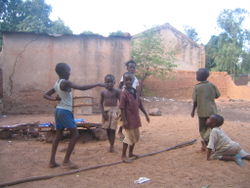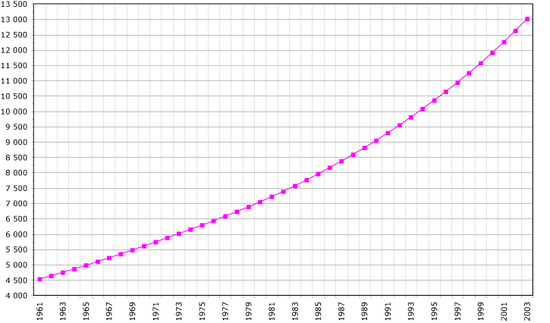Demographics of Mali
2007 Schools Wikipedia Selection. Related subjects: African Geography
Mali's population consists of diverse Sub-Saharan ethnic groups, sharing similar historic, cultural, and religious traditions. Exceptions are the Tuaregs and Maurs, desert nomads, related to the North African Berbers. The Tuaregs traditionally have opposed the central government. Starting in June 1990 in the north, Tuaregs seeking greater autonomy led to clashes with the military. In April 1992, the government and most opposing factions signed a pact to end the fighting and restore stability in the north. Its major aims are to allow greater autonomy to the north and increase government resource allocation to what has been a traditionally impoverished region. The peace agreement was celebrated in 1996 in Timbuktu during an official and highly publicized ceremony called " Flamme de la Paix"--(peace flame).
Historically, good interethnic relations throughout the rest of the country were facilitated by easy mobility on the Niger River and across the country's vast savannahs. Each ethnic group was traditionally tied to a specific occupation, all working within proximity to each other. The Bambara, Malinké, Sarakole, and Dogon and Songhay are farmers; the Fulani, Maur, and Tuareg are herders, while the Bozo are fishers. In recent years, this linkage has shifted as ethnic groups seek diverse, nontraditional sources of income.
Although each ethnic group speaks a separate language, nearly 80% of Malians communicate in Bambara, the common language of the marketplace. Malians enjoy a relative harmony rare in African states.
Population: 11,716,829 (July 2006 est.)
Age structure:
0-14 years: 48.2% (male 2,857,670; female 2,787,506)
15-64 years: 48.8% (male 2,804,344; female 2,910,097)
65 years and over: 3% (male 146,458; female 210,754) (2006 est.)
Population growth rate: 2.63% (2006 est.)
Birth rate: 49.82 births/1,000 population (2006 est.)
Death rate: 16.89 deaths/1,000 population (2006 est.)
Net migration rate: -6.6 migrant(s)/1,000 population (2006 est.)
Sex ratio:
at birth: 1.03 male(s)/female
under 15 years: 1.03 male(s)/female
15-64 years: 0.96 male(s)/female
65 years and over: 0.7 male(s)/female
total population: 0.98 male(s)/female (2006 est.)
Infant mortality rate:
total: 107.58 deaths/1,000 live births
male: 117.32 deaths/1,000 live births
female: 97.54 deaths/1,000 live births (2006 est.)
Life expectancy at birth:
total population: 49 years
male: 47.06 years
female: 51.01 years (2006 est.)
Total fertility rate: 7.42 children born/woman (2006 est.)
HIV/AIDS - adult prevalence rate: 1.9% (2003 est.)
HIV/AIDS - people living with HIV/AIDS: 140,000 (2003 est.)
HIV/AIDS - deaths: 12,000 (2003 est.)
Nationality:
noun: Malian(s)
adjective: Malian
Ethnic groups: Mande 50% (Bambara, Malinke, Soninke), Peul 17%, Voltaic 12%, Songhai 6%, Tuareg and Moor 10%, other 5%
Religions: Muslim 90%, indigenous beliefs 9%, Christian 1%
Languages: French (official, somewhat spoken by 30%), Bambara 80%, numerous African languages
Literacy:
definition: age 15 and over can read and write
total population: 38%
male: 45%
female: 31% (1998 est.)
- See also : Mali
Algeria • Angola • Benin • Botswana • Burkina Faso • Burundi • Cameroon • Cape Verde • Central African Republic • Chad • Comoros • Democratic Republic of the Congo • Republic of the Congo • Côte d'Ivoire (Ivory Coast) • Djibouti • Egypt • Equatorial Guinea • Eritrea • Ethiopia • Gabon • The Gambia • Ghana • Guinea • Guinea-Bissau • Kenya • Lesotho • Liberia • Libya • Madagascar • Malawi • Mali • Mauritania • Mauritius • Morocco • Mozambique • Namibia • Niger • Nigeria • Rwanda • São Tomé and Príncipe • Senegal • Seychelles • Sierra Leone • Somalia • South Africa • Sudan • Swaziland • Tanzania • Togo • Tunisia • Uganda • Western Sahara (Sahrawi Arab Democratic Republic) • Zambia • Zimbabwe
Dependencies and other territories
British Indian Ocean Territory • Canary Islands • Ceuta • Melilla • Madeira Islands • Mayotte • Réunion • St. Helena

